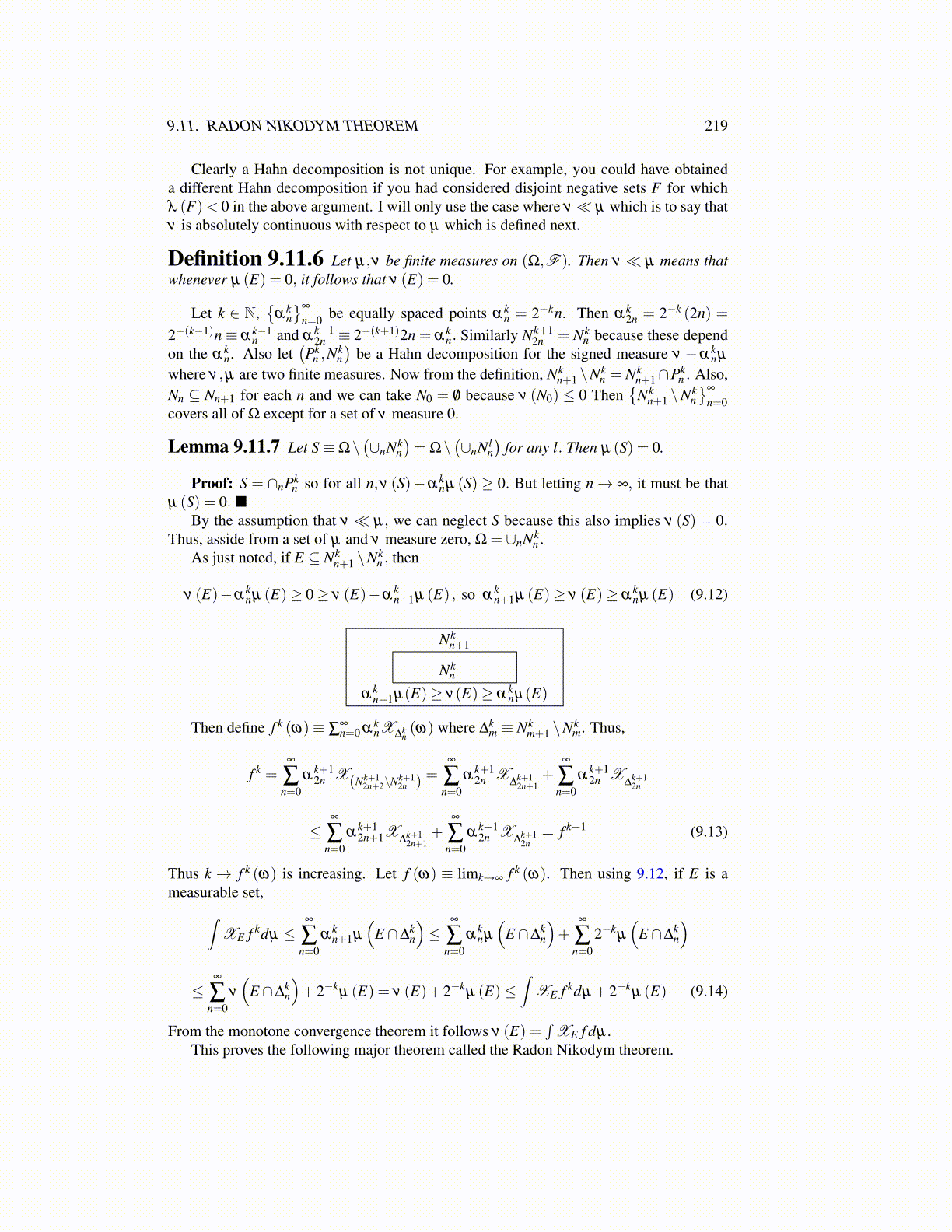
9.11. RADON NIKODYM THEOREM 219
Clearly a Hahn decomposition is not unique. For example, you could have obtaineda different Hahn decomposition if you had considered disjoint negative sets F for whichλ (F)< 0 in the above argument. I will only use the case where ν≪ µ which is to say thatν is absolutely continuous with respect to µ which is defined next.
Definition 9.11.6 Let µ,ν be finite measures on (Ω,F ). Then ν ≪ µ means thatwhenever µ (E) = 0, it follows that ν (E) = 0.
Let k ∈ N,{
αkn}∞
n=0 be equally spaced points αkn = 2−kn. Then αk
2n = 2−k (2n) =2−(k−1)n≡ αk−1
n and αk+12n ≡ 2−(k+1)2n = αk
n. Similarly Nk+12n = Nk
n because these dependon the αk
n. Also let(Pk
n ,Nkn)
be a Hahn decomposition for the signed measure ν −αknµ
where ν ,µ are two finite measures. Now from the definition, Nkn+1 \Nk
n = Nkn+1∩Pk
n . Also,Nn ⊆ Nn+1 for each n and we can take N0 = /0 because ν (N0) ≤ 0 Then
{Nk
n+1 \Nkn}∞
n=0covers all of Ω except for a set of ν measure 0.
Lemma 9.11.7 Let S≡Ω\(∪nNk
n)= Ω\
(∪nNl
n)
for any l. Then µ (S) = 0.
Proof: S = ∩nPkn so for all n,ν (S)−αk
nµ (S) ≥ 0. But letting n→ ∞, it must be thatµ (S) = 0. ■
By the assumption that ν ≪ µ, we can neglect S because this also implies ν (S) = 0.Thus, asside from a set of µ and ν measure zero, Ω = ∪nNk
n .As just noted, if E ⊆ Nk
n+1 \Nkn , then
ν (E)−αknµ (E)≥ 0≥ ν (E)−α
kn+1µ (E) , so α
kn+1µ (E)≥ ν (E)≥ α
knµ (E) (9.12)
Nkn
Nkn+1
αkn+1µ(E)≥ ν(E)≥ αk
nµ(E)
Then define f k (ω)≡ ∑∞n=0 αk
nX∆kn(ω) where ∆k
m ≡ Nkm+1 \Nk
m. Thus,
f k =∞
∑n=0
αk+12n X(Nk+1
2n+2\Nk+12n ) =
∞
∑n=0
αk+12n X
∆k+12n+1
+∞
∑n=0
αk+12n X
∆k+12n
≤∞
∑n=0
αk+12n+1X∆
k+12n+1
+∞
∑n=0
αk+12n X
∆k+12n
= f k+1 (9.13)
Thus k → f k (ω) is increasing. Let f (ω) ≡ limk→∞ f k (ω). Then using 9.12, if E is ameasurable set,∫
XE f kdµ ≤∞
∑n=0
αkn+1µ
(E ∩∆
kn
)≤
∞
∑n=0
αknµ
(E ∩∆
kn
)+
∞
∑n=0
2−kµ
(E ∩∆
kn
)
≤∞
∑n=0
ν
(E ∩∆
kn
)+2−k
µ (E) = ν (E)+2−kµ (E)≤
∫XE f kdµ +2−k
µ (E) (9.14)
From the monotone convergence theorem it follows ν (E) =∫
XE f dµ .This proves the following major theorem called the Radon Nikodym theorem.